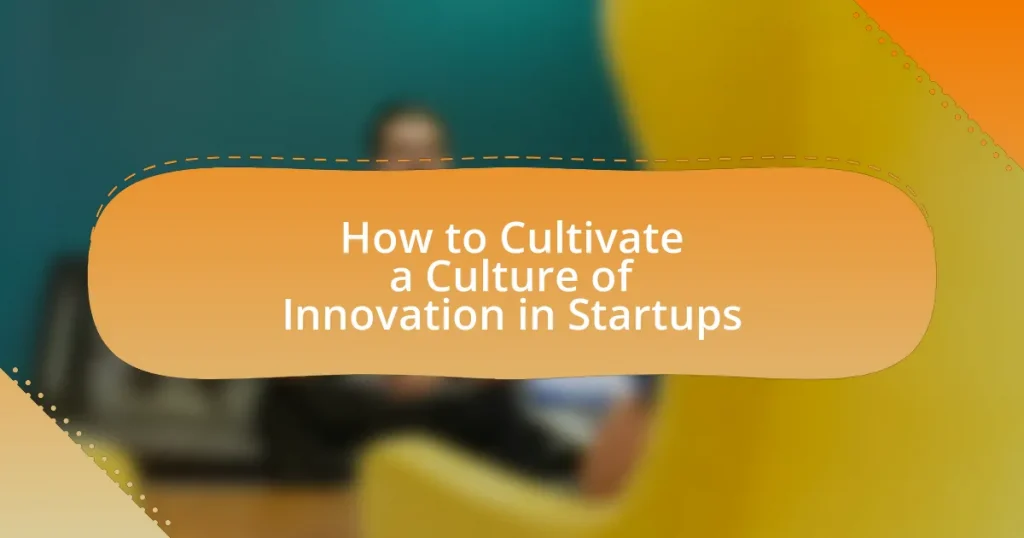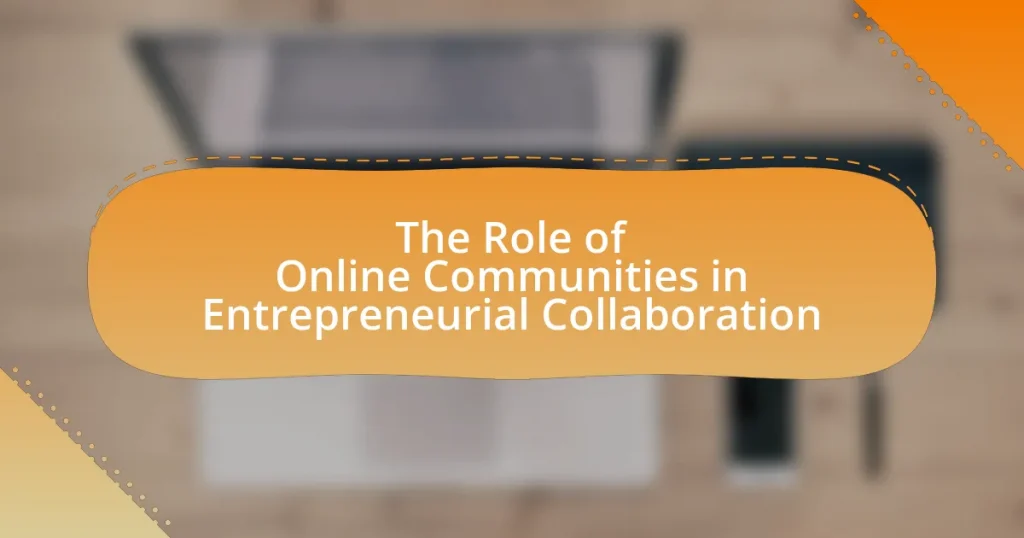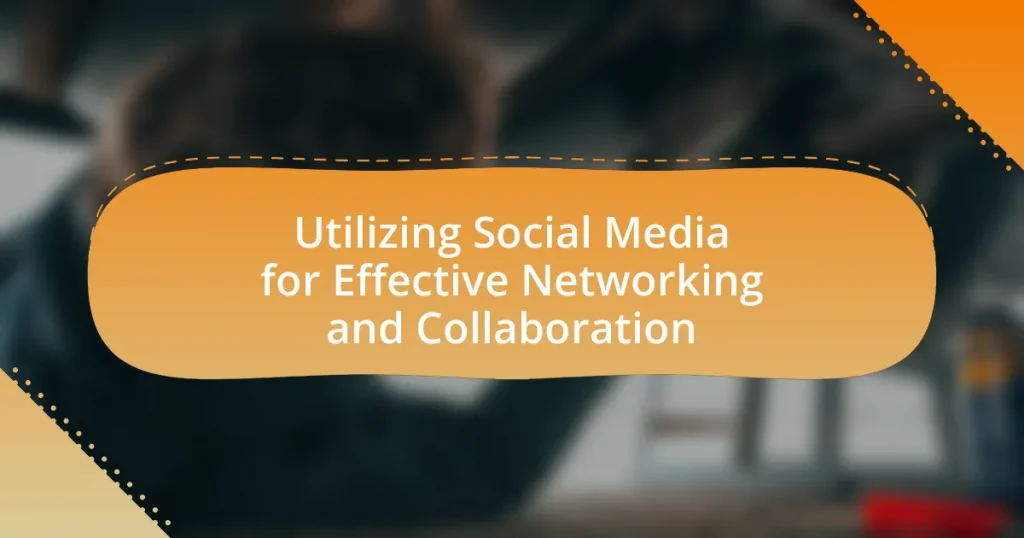The article focuses on cultivating a culture of innovation in startups, emphasizing the importance of fostering an environment that encourages creativity, experimentation, and collaboration. It outlines how startups can define innovation within their context, highlighting key characteristics of an innovative culture, and the varying nature of innovation across different startup stages. The article also discusses the significance of innovation for competitive advantage, customer satisfaction, and loyalty, while providing strategies for leadership to promote an innovative mindset among employees. Additionally, it addresses challenges startups face in nurturing innovation and offers practical tips to enhance their innovation culture.

What does it mean to cultivate a culture of innovation in startups?
Cultivating a culture of innovation in startups means fostering an environment that encourages creativity, experimentation, and the pursuit of new ideas. This involves implementing practices that support risk-taking, collaboration, and open communication among team members. For instance, startups that prioritize innovation often establish cross-functional teams, provide resources for research and development, and celebrate both successes and failures as learning opportunities. Research indicates that companies with strong innovation cultures, such as Google and Amazon, experience higher employee engagement and improved market performance, demonstrating the tangible benefits of such an approach.
How can startups define innovation within their context?
Startups can define innovation within their context as the process of creating new value through unique products, services, or processes that address specific market needs. This definition emphasizes the importance of aligning innovation efforts with the startup’s mission and target audience. For instance, a study by the Harvard Business Review highlights that successful startups often innovate by leveraging their agility to respond quickly to customer feedback, thereby tailoring their offerings to meet evolving demands. This approach not only fosters a culture of innovation but also enhances competitive advantage in rapidly changing markets.
What are the key characteristics of an innovative startup culture?
An innovative startup culture is characterized by flexibility, collaboration, and a strong emphasis on experimentation. Flexibility allows teams to adapt quickly to changes and pivot when necessary, fostering an environment where new ideas can flourish. Collaboration encourages diverse perspectives and teamwork, which enhances creativity and problem-solving. A strong emphasis on experimentation promotes risk-taking and learning from failures, essential for innovation. According to a study by the Harvard Business Review, companies that prioritize these characteristics are more likely to achieve breakthrough innovations and maintain competitive advantages in their industries.
How does innovation differ across various startup stages?
Innovation varies significantly across startup stages, primarily categorized into ideation, validation, growth, and maturity. In the ideation stage, innovation focuses on generating and refining ideas, often through brainstorming and market research to identify unmet needs. During the validation stage, startups test their concepts through prototypes and minimum viable products (MVPs), emphasizing customer feedback to iterate on their offerings. In the growth stage, innovation shifts towards scaling operations and enhancing product features based on market demand, often involving strategic partnerships and increased investment in technology. Finally, in the maturity stage, innovation centers on sustaining competitive advantage through diversification and optimization of existing products, as well as exploring new markets. This progression illustrates how the nature and focus of innovation evolve as startups transition through different phases of development.
Why is fostering innovation crucial for startup success?
Fostering innovation is crucial for startup success because it enables companies to differentiate themselves in competitive markets. Startups that prioritize innovation can develop unique products or services that meet emerging customer needs, leading to increased market share and customer loyalty. For instance, according to a study by the Harvard Business Review, innovative companies grow their revenues 2.5 times faster than their competitors. This growth is often driven by the ability to adapt quickly to changing market conditions and consumer preferences, which is essential for survival in the fast-paced startup environment.
What impact does innovation have on competitive advantage?
Innovation significantly enhances competitive advantage by enabling organizations to differentiate their products and services, thereby attracting more customers. Companies that prioritize innovation can respond more effectively to market changes and consumer demands, leading to increased market share. For instance, a study by the Harvard Business Review found that firms with strong innovation capabilities outperform their competitors by 30% in terms of revenue growth. This demonstrates that innovation not only fosters unique offerings but also drives financial success, solidifying a company’s position in the marketplace.
How does innovation influence customer satisfaction and loyalty?
Innovation directly enhances customer satisfaction and loyalty by providing improved products and services that meet evolving consumer needs. When companies introduce innovative solutions, they often address pain points more effectively, leading to a better user experience. For instance, a study by PwC found that 73% of consumers consider customer experience an important factor in their purchasing decisions, indicating that innovation in service delivery can significantly impact satisfaction levels. Furthermore, companies that consistently innovate tend to build stronger emotional connections with their customers, fostering loyalty; research from Harvard Business Review shows that emotionally connected customers are more than twice as valuable as highly satisfied customers. Thus, innovation not only satisfies existing customer demands but also cultivates long-term loyalty through enhanced engagement and experience.

What strategies can startups implement to encourage innovation?
Startups can implement strategies such as fostering a collaborative environment, encouraging risk-taking, and investing in continuous learning to encourage innovation. A collaborative environment promotes idea sharing and diverse perspectives, which can lead to creative solutions. Encouraging risk-taking allows employees to experiment without fear of failure, which is essential for innovation. Additionally, investing in continuous learning through workshops and training keeps the team updated on industry trends and new technologies, further enhancing innovative capabilities. Research shows that companies with a strong culture of innovation are 3.5 times more likely to outperform their competitors in terms of revenue growth, highlighting the effectiveness of these strategies.
How can leadership promote an innovative mindset among employees?
Leadership can promote an innovative mindset among employees by fostering an environment that encourages creativity and risk-taking. This can be achieved through open communication, where leaders actively solicit and value employee input, thereby creating a sense of ownership and engagement. Research indicates that companies with a strong culture of innovation, such as Google, implement practices like allowing employees to dedicate time to personal projects, which enhances creativity and leads to innovative solutions. Furthermore, providing resources for professional development and recognizing and rewarding innovative efforts can significantly motivate employees to think outside the box.
What role does communication play in fostering innovation?
Communication is essential in fostering innovation as it facilitates the exchange of ideas, encourages collaboration, and enhances problem-solving. Effective communication allows team members to share diverse perspectives, which can lead to creative solutions and new concepts. Research indicates that organizations with open communication channels are 25% more likely to be innovative, as they create an environment where employees feel valued and empowered to contribute. This dynamic not only accelerates the innovation process but also strengthens team cohesion and adaptability, crucial for startups aiming to thrive in competitive markets.
How can leaders model innovative behavior effectively?
Leaders can model innovative behavior effectively by actively demonstrating risk-taking, encouraging experimentation, and fostering open communication. By taking calculated risks themselves, leaders set a precedent that innovation is valued, as evidenced by companies like Google, which allows employees to spend 20% of their time on personal projects, leading to successful products like Gmail. Additionally, leaders should create an environment where team members feel safe to experiment without fear of failure, as shown in research by Ed Catmull of Pixar, which emphasizes that a culture of experimentation leads to greater creativity and innovation. Finally, leaders must maintain open lines of communication, inviting feedback and diverse ideas, which has been proven to enhance collaborative innovation, as seen in the practices of successful startups like Slack.
What practices can be adopted to support creative thinking?
To support creative thinking, practices such as fostering an open environment, encouraging collaboration, and implementing brainstorming sessions can be adopted. An open environment allows individuals to express ideas without fear of criticism, which has been shown to enhance creativity. Collaboration among diverse teams brings together different perspectives, leading to innovative solutions. Additionally, structured brainstorming sessions can stimulate idea generation, as evidenced by studies indicating that group brainstorming can produce more ideas than individual efforts alone.
How can brainstorming sessions be structured for maximum output?
To structure brainstorming sessions for maximum output, implement a clear agenda, set time limits, and encourage diverse participation. A defined agenda ensures that all participants understand the session’s goals, while time limits foster focused discussions and prevent digressions. Encouraging diverse participation brings varied perspectives, which enhances creativity and idea generation. Research indicates that diverse teams can outperform homogeneous groups in problem-solving tasks, as highlighted in a study by Page (2007) in “The Difference: How the Power of Diversity Creates Better Groups, Firms, Schools, and Societies.” This structured approach maximizes the effectiveness of brainstorming sessions, leading to innovative solutions and a stronger culture of innovation within startups.
What tools and technologies can facilitate innovation in startups?
Cloud computing platforms, collaboration tools, and data analytics technologies can facilitate innovation in startups. Cloud computing platforms like Amazon Web Services and Microsoft Azure provide scalable resources that enable startups to develop and deploy applications quickly without heavy upfront investment. Collaboration tools such as Slack and Trello enhance team communication and project management, fostering a collaborative environment essential for innovation. Data analytics technologies, including Google Analytics and Tableau, allow startups to gather insights from customer data, driving informed decision-making and innovative product development. These tools collectively create an ecosystem that supports rapid experimentation and agile responses to market needs, which is crucial for startup success.

What challenges do startups face in cultivating a culture of innovation?
Startups face several challenges in cultivating a culture of innovation, primarily due to limited resources, high uncertainty, and the need for rapid scalability. Limited financial and human resources often restrict startups from investing in research and development, which is crucial for fostering innovation. High uncertainty in market conditions can lead to risk-averse behavior, discouraging experimentation and creative thinking. Additionally, the pressure to achieve quick results can stifle long-term innovative initiatives, as startups may prioritize immediate profitability over exploratory projects. According to a study by the Harvard Business Review, 70% of startups fail due to premature scaling, highlighting the difficulty of balancing innovation with operational demands.
How can startups overcome resistance to change?
Startups can overcome resistance to change by fostering open communication and involving employees in the change process. Engaging team members in discussions about the reasons for change helps to build trust and reduces fear. Research indicates that organizations with high levels of employee involvement in decision-making experience 25% less resistance to change (Kotter, 1996). Additionally, providing training and support during transitions equips employees with the necessary skills and confidence to adapt, further mitigating resistance.
What strategies can be employed to manage fear of failure?
To manage fear of failure, individuals can employ strategies such as reframing failure as a learning opportunity, setting realistic goals, and practicing self-compassion. Reframing failure allows individuals to view setbacks as valuable experiences that contribute to personal and professional growth, which is supported by research indicating that a growth mindset enhances resilience (Dweck, 2006). Setting realistic goals helps to reduce the pressure associated with high expectations, making it easier to take risks without the paralyzing fear of failure. Practicing self-compassion involves treating oneself with kindness during challenging times, which has been shown to decrease anxiety and improve emotional well-being (Neff, 2003). These strategies collectively foster an environment conducive to innovation, particularly in startup cultures where experimentation is essential.
How can startups balance innovation with operational efficiency?
Startups can balance innovation with operational efficiency by implementing agile methodologies that promote iterative development while optimizing resource allocation. Agile practices, such as Scrum or Kanban, allow teams to adapt quickly to changes and focus on delivering value, which enhances innovation. Simultaneously, these methodologies emphasize continuous improvement and efficiency in processes, ensuring that resources are used effectively. Research from the Project Management Institute indicates that organizations using agile practices report a 71% higher success rate in project delivery, demonstrating that this approach effectively merges innovation with operational efficiency.
What are common pitfalls to avoid when fostering innovation?
Common pitfalls to avoid when fostering innovation include a lack of clear vision, insufficient resources, and resistance to change. A lack of clear vision can lead to confusion among team members about innovation goals, resulting in fragmented efforts and wasted resources. Insufficient resources, such as time, funding, and personnel, can stifle innovative projects before they gain traction. Resistance to change often manifests as a reluctance to adopt new ideas or processes, which can hinder the implementation of innovative solutions. Research by the Harvard Business Review indicates that organizations with a clear innovation strategy are 3.5 times more likely to achieve significant growth compared to those without one, highlighting the importance of avoiding these pitfalls.
How can startups ensure they do not stifle creativity?
Startups can ensure they do not stifle creativity by fostering an open and inclusive environment that encourages diverse ideas and experimentation. This can be achieved by implementing practices such as regular brainstorming sessions, where all team members feel safe to share their thoughts without judgment, and promoting a culture that values feedback and collaboration. Research indicates that companies with a strong emphasis on employee engagement and empowerment see a 21% increase in productivity, which directly correlates with enhanced creativity. Additionally, providing resources for professional development and allowing flexible work arrangements can further stimulate innovative thinking among employees.
What signs indicate that a startup’s innovation culture is failing?
Signs that indicate a startup’s innovation culture is failing include a lack of idea generation, resistance to change, and low employee engagement. When employees do not contribute new ideas or feel discouraged from sharing them, it reflects a stagnant culture. Resistance to change often manifests as reluctance to adopt new technologies or processes, which can hinder growth and adaptability. Additionally, low employee engagement, characterized by minimal participation in brainstorming sessions or innovation initiatives, suggests that the workforce is not invested in the company’s innovative goals. These signs collectively indicate a breakdown in the innovation culture essential for a startup’s success.
What practical tips can startups follow to enhance their innovation culture?
Startups can enhance their innovation culture by fostering an open environment that encourages experimentation and collaboration. This can be achieved by implementing regular brainstorming sessions where all team members contribute ideas, thus promoting inclusivity and diverse perspectives. Additionally, providing resources for continuous learning, such as workshops and access to online courses, empowers employees to develop new skills and stay updated on industry trends. Research indicates that companies with a strong culture of innovation, such as Google, allocate time for employees to work on personal projects, leading to significant breakthroughs like Gmail and Google News. By prioritizing these practices, startups can create a dynamic atmosphere that nurtures creativity and drives innovation.



